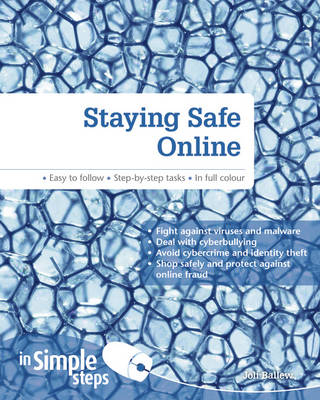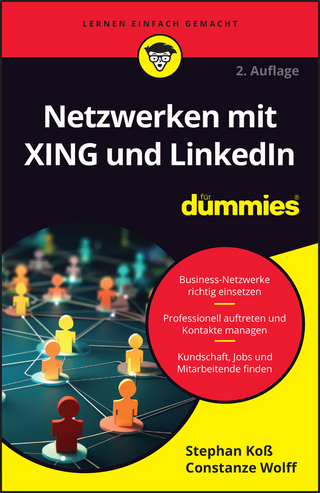
Staying Safe Online In Simple Steps
Pearson Education Limited (Verlag)
978-0-273-77473-0 (ISBN)
- Titel ist leider vergriffen;
keine Neuauflage - Artikel merken
This book is for anyone who is starting to undertake more and more social, home and financial activities online and who is worrying about the best way to keep themselves and their personal information safe whilst doing so. It outlines basic safety and security strategies, tools and resources that are available for use, and will strip away the panic, mystique and insecurity around areas of concern for anyone going online, such as viruses & malware, identity theft, email hoaxes & scams, information security, safety in social networking and keeping kids and grandkids safe from cyberbullying.
This series of vibrant books will teach you exactly what you need to know using
A friendly, visual approach
Easy-to-understand language
Practical hands-on tasks
Full-colour large format screenshots
To build your confidence and help you to get the most out of your computer, practical hints, tips and shortcuts feature on every page:
§ ALERT!– Explains and provides practical solutions to the most commonly
encountered problems
§ HOT TIPS– Time and effort saving shortcuts
§ SEE ALSO… - Points you to other related tasks and information
§ DID YOU KNOW? – Additional features to explore
§ WHAT DOES THIS MEAN?– Jargon and technical terms explained in plain English
Top 10 staying safe online tips
1. Create strong passwords for websites
2. Install anti-virus software
3. Know common signs of scam emails
4. Explore your web browser’s safety and security options
5. Don’t click ads!
6. Learn what you should never share online
7. Obtain free software safely
8. Consider free software like Windows Live Family Safety
9. Log off or lock your computer
10. Check for and resolve security issues
1. Introduction to internet safety
Protect all personal devices with a password
Create strong passwords for websites
Protect your list of passwords
Install anti-virus software
Avoid common email scams
Don’t open email attachments (yet)
Know how to perform web searches
Avoid phishing emails
Look for the ‘s’ before making an online purchase
Be mindful in public places
2. Fighting against viruses, adware, and malware
Identify the threats
Know who not to trust
Enable a firewall
Learn the signs and symptoms of infection
Verify with Snopes
Learn how to be safe on Facebook
Obtain security software
Install security software
Verify settings
Explore Windows Defender
Run checks for viruses and malware
Remove spyware with Windows Defender
Remove viruses and malware with the Malicious Software Removal Tool
3. Avoiding threats in email
Keep your email program up to date
Know common signs of scam emails
Don’t talk to strangers!
Explore the validity of the sender’s name
Hover before you click that link
When in doubt, visit the entity’s official website
Triple check before opening an attachment
Configure a junk email filter
Block unwanted senders
4. Avoiding spam
Don’t share your primary email address
Tell your friends and family not to share your email address
Unsubscribe from legitimate mailing lists
Unsubscribe from unwanted social network email
Know what to do when you can’t click Unsubscribe
Block email from entire domains
Block email from foreign countries
Obtain a secondary email address
Know when to use your secondary email address
Avoid unwittingly signing up for unwanted email
Opt not to receive email from third parties
Opt not to download images in emails
Set a stronger spam filter
5. Using alternative web browsers
Explore Internet Explorer 9
Explore Firefox
Explore Chrome
Explore Safari
Locate browser installation files
Download and install a browser
Import and access existing favourites and bookmarks
Access and configure settings
Show toolbars and menus
Use thumbnail views
Be mindful of the Address bar
Avoid installing toolbars and add-ons
Explore safety and security options
6. Avoiding phishing, pop-ups, ads and other website threats
Don’t click ads!
Enable a pop-up blocker
Skip ads that appear on web pages
Avoid phishing websites
Report an unsafe website
Understand cookies
Delete browsing history
Keep your browsers up to date
Consider private browsing options
7. Shopping safely on the web
Find websites you can trust
Look for third-party seals of approval
Read reviews
Create strong passwords
Look for the VeriSign logo
Make purchases from your home computer
Choose the right credit card
Consider PayPal
Verify the shipping address
Keep receipts and return slips and check credit card statements
Be safe on eBay
Use iTunes
8. Using social networking sites safely
Know which social networks to use
Protect your password
Learn what you should never share online
Know what you’re sharing by default
Limit who can view your profile
Edit profile information
Edit personal information
Understand messaging options
Unsubscribe from and stop following undesirable people
Learn how to ask someone to remove content
Report abusive content
Be careful what you click
Be careful with Facebook games
Learn how to protect your social networking account
9. Sharing your personal information on the web
Register only if it’s mandatory
Create screen names carefully
Know how to post anonymously
Share photos safely
Learn how to blog safely
Be careful what you share on dating websites
Be careful what you post on YouTube
Explore ways to expunge information from the web
‘Google’ yourself
Use Google’s encrypted search feature
Make sure your computer is protected
Educate family members
Look for your house on Google maps
10. Exploring free software
Don’t install anything, yet!
Understand the ruse behind the ‘free scan’
Obtain free software safely
Explore the Microsoft Fix It Solution Center
Explore Ad-Aware
Explore OpenOffice
Use Amazon’s Kindle Cloud Reader
Choose and use a messaging program
Find more free software you can trust
Be careful with free trials
Uninstall unwanted software
11. Keeping children and grandchildren safe
Understand the basic protection strategies
Create standard computer user accounts
Password protect all computer accounts
Configure the Content Advisor in Internet Explorer
Locate parental control add-ons in Firefox
Uninstall or limit access to other installed web browsers
Explore Google’s SafeSearch
Explore parental controls in Windows 7
Consider free software like Windows Live Family Safety
Educate yourself about the sites children visit
Modify the list of blocked websites
12. Dealing with cyberbullying, cybercrime, and cyberstalking
Understand the threats
Know what to do first when problems begin
Record online attacks
Keep a folder of personal attacks
Print what you can
Report a cyberbully
Report cyber crime
Report cyberstalking
Change your email address, user names, and passwords
Change or suspend social networking accounts
13. Securing your computer and network
Log off or lock your computer
Check for and resolve security issues
Find and fix problems
Change administrator accounts to standard accounts
Keep your operating system up to date
Check for optional updates
Keep programs up to date
Keep your web browser up to date
Verify your Wi-Fi network is password-protected
Top 10 Staying Safe Online Problems Solved
1. My computer is acting strangely, but it’s not a virus!
2. I created an account for my grandchild but he keeps logging on to mine!
3. My child is being bullied online. How do I report it?
4. How can I best protect my computer from viruses and other malware?
5. I want to report an unsafe website.
6. I’ve been shopping for presents and need to delete my browsing history.
7. How can I be sure that I can trust a website with my credit card information?
8. I think my computer has a virus. What can I do?
9. When I visit websites, I have to close a lot of pop-up ads.
10. My child installed software I didn’t approve of. How can I prevent this in future?
| Verlagsort | Harlow |
|---|---|
| Sprache | englisch |
| Maße | 189 x 234 mm |
| Gewicht | 490 g |
| Themenwelt | Mathematik / Informatik ► Informatik ► Web / Internet |
| ISBN-10 | 0-273-77473-5 / 0273774735 |
| ISBN-13 | 978-0-273-77473-0 / 9780273774730 |
| Zustand | Neuware |
| Informationen gemäß Produktsicherheitsverordnung (GPSR) | |
| Haben Sie eine Frage zum Produkt? |
aus dem Bereich


